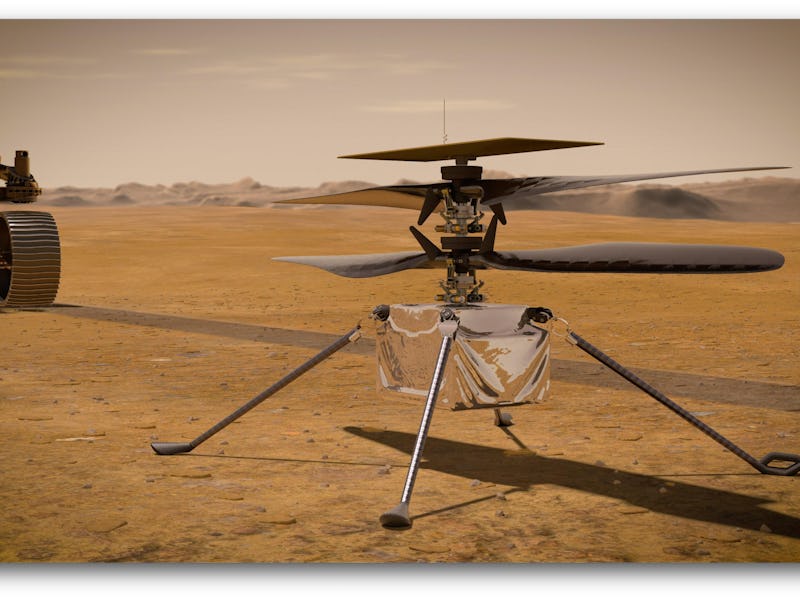The Mars Helicopter has already passed its first crucial test
Flying to Mars is one thing, but flying on Mars is an entirely different degree of difficulty.

Machines in space often run into the same problems as machines on Earth. The only problem is there’s rarely anybody in space to fix them, which is why they typically need to be more self-reliant than your average electronics — and the Mars Helicopter is no exception. NASA announced this week that it's now powering up and recharging itself in space.
The Mars Helicopter, also known as Ingenuity, is riding along with the Perseverance rover on a long journey to Mars. The two are only one week into a seven-month journey, making this the perfect time to make sure that the Helicopter could actually function in space.
READ MORE PERSEVERANCE ROVER NEWS FROM INVERSE
Tim Canham, the operations lead for Mars Helicopter at NASA's Jet Propulsion Laboratory, said in a press statement that the charging was a “big milestone.”
“It was our first opportunity to turn on Ingenuity and give its electronics a 'test drive' since we launched on July 30," he said. "Since everything went by the book, we'll perform the same activity about every two weeks to maintain an acceptable state of charge.”
The Mars Helicopter can be seen in this image, tucked safely inside the belly of Perseverance between the rover's left and center rover wheels.
Ingenuity is small at just four pounds of specially designed and off-the-shelf parts, and is currently tucked away inside the rover. Charging Ingenuity from the inside was an eight-hour endeavor, with the Helicopter’s six lithium-ion batteries charged up to thirty-five percent. That number might make you worried about your phone, but it’s exactly what NASA wanted. Keeping a low charge during the long journey is best for the battery’s health in the long term.
Once Ingenuity gets to Mars, it won’t be able to rely on Perseverance for charging anymore. The rover will have its own activities to attend to, namely looking for signs of ancient life on the Red Planet. So the Helicopter will use its own solar panels to recharge.
A flight model of Ingenuity. The Helicopter will have to rely on the solar panel on top for charging once it reaches Mars.
NASA openly called Ingenuity a test since helicopters have only flown on Earth. There will be several challenges ahead of the small copter, ranging from the thin Martian atmosphere to bitter cold nights, which can hover around -100 F. It’s already surviving the harshness of space, says MiMi Aung, the Ingenuity Mars Helicopter project manager at JPL, and that’s reason for optimism.
"We have a lot more firsts to go before we can attempt the first experimental flight test on another planet, but right now we're all feeling very good about the future," she says.
If everything goes as planned for the Mars Helicopter, NASA will have a fantastic research vessel on its hands. The ability fly will greatly expand the amount of area NASA can cover during missions, assuming helicopter flight is possible on Mars at all.
Rovers are wonderful, but they can only go so far and struggle up steep hills. If humans ever wanted to explore, say, the 16-mile high volcano Mons Olympus, without going there on foot, a helicopter seems like a perfect option.
Olympus Mons, with the map of the state of Arizona for comparison. So far, NASA has only been able to explore the volcano from above. Flight capabilities could change that.
But bounding across Mars and flying up volcanoes will all have to wait. The first steps of Martian flight will resemble the first steps of the Wright Brothers on Earth: small. After its trip into the atmosphere, Ingenuity will attempt to hover in the air for 20 to 30 seconds. A small flight for Ingenuity, with the potential to be a giant leap for mankind.